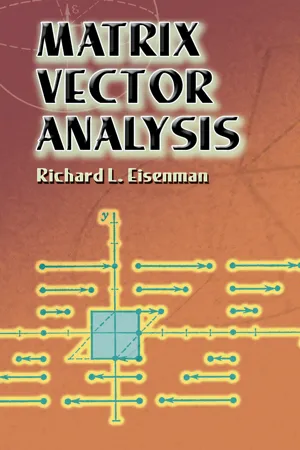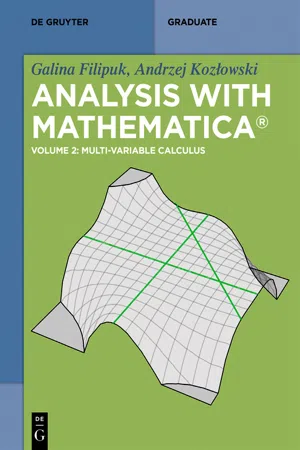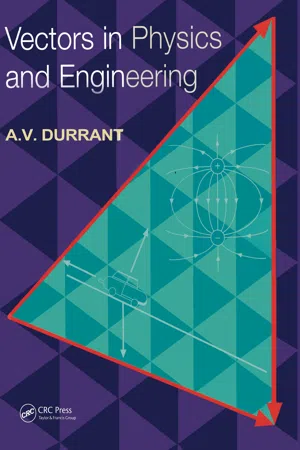Technology & Engineering
Derivative of a Vector
The derivative of a vector is a mathematical operation that calculates the rate of change of a vector with respect to time or another variable. It is commonly used in engineering and physics to describe the motion of objects in space. The derivative of a vector is a vector itself, with each component representing the rate of change of the corresponding component of the original vector.
Written by Perlego with AI-assistance
Related key terms
Related key terms
1 of 4
Related key terms
1 of 3
4 Key excerpts on "Derivative of a Vector"
- eBook - ePub
- Richard L. Eisenman(Author)
- 2013(Publication Date)
- Dover Publications(Publisher)
changes magnitude and changes direction.has fixed magnitude and fixed direction and is the only one of these examples which deserves to be called a “constant vector.” (Notice that even this vector might be changing if a different basis were chosen, because the new basis vectors may move with t.)The concept of change is an inseparable companion of the concept of rate of change. You have defined and used the idea of the derivative of a scalar function. The concept of derivative as limit of the quotient of increments may be hazy, in which case you owe it to yourself to review this idea and report to yourself on the natural way to extend to .Although derivatives of vectors may be defined in terms of an increment of the entire vector, it is equally profitable to define this new kind of derivative in terms of the already established idea of derivative of a scalar. Refer the vector function to a fixed basis and simply differentiate the coordinates, treating the basis as constants.Definition: If , the derivative of with reference to is .A dot above a scalar, as introduced by Sir Isaac Newton, indicates differentiation with respect to time t. When the rectangular frame is clearly understood, the subscript need not appear.Example:a.b.Note that could also be handled as from which, differentiating like a product,From one viewpoint, we have merely differentiated coordinates, and you may see why we spoke of the derivative with respect to the basis for a new basis would bring new coordinates with new derivatives. From a slightly different viewpoint, we have taken the derivative of a matrix; i.e., we have differentiated each coordinate or matrix element separately. To get the derivative with respect to some basis means to differentiate the matrix of the coordinates and to consider the basis matrix - eBook - ePub
- Galina Filipuk, Andrzej Kozłowski(Authors)
- 2020(Publication Date)
- De Gruyter(Publisher)
2 Differentiation of functions of many variablesThe definition of the Derivative of a Vector-valued function of several variables is less intuitive than for a single variable. The most obvious attempt to generalize the definition via the differential quotient does not work because division by vectors is not well defined. We will follow the usual approach of arriving at the definition in stages, keeping in mind that a satisfactory definition of differentiation must satisfy the following property: a function differentiable at a point is continuous at that point. We will begin with the simplest case of a vector-valued function of one variable.2.1 Derivative of a Vector-valued function of one variable
A continuous functionf : [ a , b ] →can be thought of as describing the motion of a particle along a curve inR nR n. If at time t the particle has a well defined velocity, we say that the function is differentiable at t and its velocity vector is its derivative. As is well known from mechanics, the velocity is a vector whose components in the directions of the axes (or basic unit vectors) are the velocities of the projections of the point on the coordinate axes. Thus, the velocity at time t is the vector(of derivatives of its components. Such a function f therefore is differentiable if all of its components are differentiable. This, in turn, implies that they are continuous, which, as we already know, implies that the function itself is continuous.f 1 ′( t ) , … ,f n ′( t ) )Let us consider the familiar example. Letf : [ 0 , 2 π ] →be given byR 2t ↦ ( cos t , sin t ). The function describes a motion on the unit circle. At time t, the position vector is( cos t , sin t )and its derivative (velocity vector) is( − sin t , cos t ). Sincethis shows that the velocity vector (blue arrow on the picture below) is perpendicular to the position vector (red arrow). Note also thatIn[·]:= f[t_] := {Cos[t], Sin[t]} In[·]:= f[t] . Derivative[1][f][t] Out[·]:= 0 - Keith C Brown(Author)
- 2020(Publication Date)
- Royal Society of Chemistry(Publisher)
4 Vector CalculusCarl Friedrich GaussMathematics is the queen of the sciences and arithmetic is the queen of mathematics. She often condescends to render service to astronomy and other natural sciences, but in all relations, she is entitled to first rank.4.1 Vector Differentiation
In order to introduce electric and magnetic field theories and, ultimately, the rationale for various parts of the NMR Hamiltonian we must review our vector calculus.†Vector differentiation (with respect to time, which is what we will ultimately be interested in) is defined for a static coordinate system by:(4.1)and for a dynamic coordinate system by:(4.2)for a rotating coordinate system in which the unit vectors are changing direction with time. Vector differentiation follows much the same rules for normal function differentiation:What direction is d x /dt in? Since x is a unit vector, d x /dt cannot change in magnitude. The only other change that is possible is a change in direction … a rotation in other words. It is easiest to picture in the situation in which the rotation is about the z -axis (see Figure 4.1 ).Figure 4.1 The rotating unit vector, .So, d x /dt is at right angles to x along the y -axis and we can write:Why x ·b x ? Since d y /dt must be at right angles to y , it must be parallel and proportional to x . The same reasoning applies to y ·a y .The vector operator, , is often referred to as del or nabla and is defined as:(4.3)The gradient is defined in terms of del and a scalar function, f (x, y, z ):(4.4)f (x, y, z ) is a scalar function that defines a scalar field and the action of on f (x , y , z ) produces a vector function (sometimes referred to as a vector-valued function). eqn (4.4) contains three components of the vector function, P , Q and R . A scalar field is a region of space in which there is a scalar value associated with each point in the space. For example, one might define a scalar field of temperatures within a region of the atmosphere. Similarly, a vector field- eBook - ePub
- Alan Durrant(Author)
- 2019(Publication Date)
- CRC Press(Publisher)
Δt is defined to be(3.17)=Δ vΔ tv( t + Δ t ) − v( t )Δ tFig 3.10bThe two velocity vectors are redrawn with a common beginning point C so that the change in velocity Δv is easily drawn using the triangle rule.The subtraction of the velocity vectors in the numerator of Eq (3.17 ) is illustrated in Fig 3.10b where the two velocity vectors are redrawn with their beginning points at a common point C. The derivative dv/dt is the limit (Δt → 0) of Eq (3.17 ). This derivative is the instantaneous acceleration a (t ) of the particle(3.18)a( t ) ==d vd td 2sdt 2( definition of acceleration )The symbol d2 s /dt 2 denotes the second derivative of s , i.e. the derivative of d2 s /dt 2 . = d(ds /dt )/dt .Just as the velocity is always tangential to the path of the particle, so the acceleration is always tangential to the space curve of the velocity function v (i). Note that the acceleration is not tangential to the path of the particle (unless the path is a straight line). In projectile motion for example the acceleration is a (t ) = g , a constant vector directed vertically downwards (Fig 3.11 ).Fig 3.11The parabolic path of a projectile. The displacement, velocity and acceleration vectors are shown at aninstant t .Summary of section 3.2- The Derivative of a Vector function f (f) is a vector function denoted by df /dr or f ′(f) and defined by Eq (3.14 ). The derivative is always tangential to the space curve of f
Index pages curate the most relevant extracts from our library of academic textbooks. They’ve been created using an in-house natural language model (NLM), each adding context and meaning to key research topics.
Explore more topic indexes
Explore more topic indexes
1 of 6
Explore more topic indexes
1 of 4



